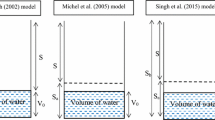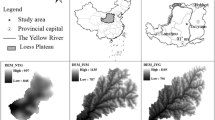Abstract
This study proposes a simplified 1-parameter SCS-CN model (M5) based on Mishra-Singh (2002) model and soil moisture accounting (SMA) procedure for surface runoff estimation and compares its performance with the existing SCS-CN method (SCS, 1956) (M1), Michel 1-P model (Water Resour Res 41:1-6, 2005) (M2), Sahu 1-P model (Hydrol Process 21:2872-2881, 2007) (M3), and Ajmal et al. model (J Hydrol 530:623-633, 2015) (M4) using large rainfall–runoff dataset of 48,763 events from123 USDA-ARS watersheds. The performance of models was evaluated using three statistical error indices such as Nash-Sutcliffe efficiency (NSE), root mean square error (RMSE), percentage bias (PBIAS), and rank and grading system (RGS). Based on the results obtained, the models can be ranked as follows: M5 > M4 > M3 > M1 > M2, i.e., model M5 outperformed all the remaining four models M1–M4 and hence is recommended for field applications.






Similar content being viewed by others
References
Ajmal M, Waseem M, Wi S, Kim TW (2015) Evolution of a parsimonious rainfall-runoff method using soil moisture proxies. J Hydrol 530:623–633
Arnold JG, Allen PM, Morgan D (2001) Hydrologic method for design of constructed wetlands. Wetlands 21(2):167–178
Aron G, Miller AC, Lakatos DF (1977) Infiltration formula based on SCS curve numbers. J Irrig Drain Divis ASCE 103(4):419–427
Banasik K, Walling D (1996) Predicting sedimentgraphs for a small agricultural catchment. Nord Hydrol 27:275–294
Banasik K, Krajewski A, Sikorska A, Hejduk L (2014) Curve number estimation for small urban catchment from recorded rainfall-runoff events. Arch Environ Prot 40:75–86
Banasik K, Hejduk L, Woodward D, Banasik J (2016) Flood peak discharge vs. various CN and rain duration in a small catchment. Rocznik Ochrona Srodowiska 18:201–212
Bhunya PK, Jain SK, Singh PK, Mishra SK (2010) A simple conceptual method of sediment yield. Water Resour Manag 24(8):1697–1716
Brocca L, Melone F, Moramarco T (2008) On the estimation of antecedent wetness conditions in rainfall-runoff modelling. Hydrol Process 22(5):629–642
Chow VT, Maidment DR, Mays LW (1988) Applied hydrology. McGraw-Hill, New York
Coffey ME, Workman SR, Taraba JL, Fogle AW (2004) Statistical procedures for evaluating daily and monthly hydrologic method predictions. Trans ASAE 47:59–68
Durbede DG, Jain MK, Mishra SK (2011) Long-term hydrologic simulation using SCS-CN based improved soil moisture accounting procedure. Hydrol Process 25(4):561–579
Fentie B, Yu B, Silburn MD, Ciesiolka CAA (2002) Evaluation of eight different methods to predict hill-slope runoff rates for a grazing catchment in Australia. J Hydrol 261:102–114
Garen D, Moore DS (2005) Curve number hydrology in water quality modelling: uses, abuses, and future directions. J Am Water Resour Assoc 41(2):377–388
Garg V, Nikam BR, Thakur PK, Aggarwal SP (2013) Assessment of the effect of slope on runoff potential of a watershed using NRCS-CN method. Int J Hydrol Sci Technol 3(2):141–159
Geetha K, Mishra SK, Eldho TI, Rastogi AK, Pandey RP (2007) Modifications to SCS-CN method for long term hydrologic simulation. J Irrig Drain Eng 133(5):475–486
Gray DD, Katz PG, deMonsabert SM, Cogo NP (1982) Antecedent moisture condition probabilities. J Irrig Drain Div 108(2):107–114
Hapuarachchi HAP, Wang QJ, Pagano TC (2011) A review of advances in flash flood forecasting. Hydrol Process 25:2771–2784
Hawkins R H, Woodward D E, Jiang R (2001) Investigation of the runoff curve number abstraction Ratio Paper presented at USDA-NRCS Hydraulic Engineering Workshop, Tucson, Arizona
Huber W C, Heaney J P, Bedient B P, Bender J P(1976) Environmental resource management studies in the Kissimmee river basin. Department of Environmental Engineering Science, University of Florida, Gainesville, Florida,Report No.ENV-05-76-3
Jain MK, Mishra SK, Babu PS, Venugopal K (2006a) On the Ia–S relation of the SCS-CN method. Hydrol Res 37(3):261–275
Jain MK, Mishra SK, Babu PS, Venugopal K, Singh VP (2006b) Enhanced runoff curve number method incorporating storm duration and a non-linear Ia-S relation. J Hydrol Eng ASCE 11(6):631–635
Jain MK, Durbude DG, Mishra SK (2012) Improved CN-based long-term hydrologic simulation method. J Hydrol Eng 17(11):1204–1220
Kannan N, Santhi C, Williams JR, Arnold JG (2008) Development of a continuous soil moisture accounting procedure for curve number methodology and its behaviour with different evapotranspiration methods. Hydrol Process 22:2114–2121
Kibbler D F(1982) Recommended hydrologic procedures for computing urban runoff from small developing Wwatersheds in Pennsylvania. Institute for Research on Land and Water Resources. The Pennsylvania State University
King KW, Balogh JC (2008) Curve number for golf course watersheds. Trans ASABE 51(3):987–996
Knisel W G(1980) CREAMS: a field-scale method for chemical, runoff and erosion from agricultural management systems. Conservation Research Report No 26, USDA, Washington, DC
Levenberg K (1944) A method for the solution of certain non-linear problems in least squares. Q Appl Math 2:164–168
Marquardt DW (1963) An algorithm for least-squares estimation of nonlinear parameters. J Soc Ind Appl Math 11(2):431–444
Merritt WS, Letcher RA, Jakeman AJ (2003) A review of erosion and sediment transport methods. Environ Model Softw 18:761–799
Michel C, Vazken A, Charles P (2005) Soil conservation service curve number method: how to mend among soil moisture accounting procedure? Water Resour Res 41(2):1–6
Mishra S K (1998) Operation of a multipurpose reservoir. Unpublished PhD thesis, University of Roorkee, India
Mishra SK, Singh VP (1999) Another look at the SCS-CN method. J Hydrol Eng 4(3):257–264
Mishra SK, Singh VP (2002) SCS-CN method: part-I: derivation of SCS-CN based models. Acta Geophys Pol 50(3):457–477
Mishra SK, Singh VP (2003) Soil conservation service curve number (SCS-CN) methodology. Kluwer Academic Publishers, Dordrecht
Mishra SK, Singh VP (2004a) Long-term hydrologic simulation based on the soil conservation service curve number. Hydrol Process 18(7):1291–1313
Mishra SK, Singh VP (2004b) Validity and extension of the SCS-CN method for computing infiltration and rainfall-excess rates. Hydrol Process 18(17):3323–3345
Mishra SK, Singh VP (2006) A relook at NEH-4 curve number data and antecedent moisture condition criteria. Hydrol Process 20(13):2755–2768
Mishra SK, Jain MK, Singh VP (2004a) Evaluation of the SCS-CN based model incorporating antecedent moisture. Water Resour Manag 18(6):567–589
Mishra SK, Sansalone JJ, Singh VP (2004b) Partitioning analog for metal elements in urban rainfall-runoff overland flow using the soil conservation service curve number concept. J Environ Eng ASCE 130(2):145–154
Mishra SK, Sansalone JJ, Glenn DW, Singh VP (2004c) PCN based metal partitioning in urban snow melt, rainfall/runoff, and river flow systems. J Am Water Resour Assoc 40(5):1315–1337
Mishra SK, Jain MK, Bhunya PK, Singh VP (2005) Field applicability of the SCS-CN-based Mishra-Singh general method and its variant. Water Resour Manag 19(1):37–62
Mishra SK, Tyagi JV, Singh VP, Singh R (2006) SCS-CN based modelling of sediment yield. J Hydrol 324:301–322
Mishra SK, Rawat SS, Pandey RP, Chakraborty S, Jain MK, Chaube UC (2014) Relationship between runoff curve number and PET. J Hydrol Eng 19:355–365
Moriasi DN, Arnold JG, Van Liew MW, Binger RL, Harmel RD, Veith T (2007) Model evaluation guidelines for systematic quantification of accuracy in watershed simulations. Trans ASABE 50:885–900
Ojha CSP (2012) Simulating turbidity removal at a river bank filtration site in India using SCS-CN approach. J Hydrol Eng 17(11):1240–1244
Pandit A, Gopalakrishnan G (1996) Estimation of annual storm runoff coefficients by continuous simulation. J Irrig Drain Eng ASCE 122(4):211–220
Patil JP, Sarangi A, Singh AK, Ahmad T (2008) Evaluation of modified CN methods for watershed runoff estimation using a GIS-based Interface. Biomass Eng 100(1):137–146
Perrin C, Michel C, Andrèassian V (2003) Improvement of a parsimonious model for streamflow simulation. J Hydrol 279:275–289
Ponce VM, Hawkins RH (1996) Runoff curve number: has it reached maturity? J Hydrol Eng 1(1):11–19
Ritter A, Muñoz-Carpena R (2013) Performance evaluation of hydrological models: statistical significance for reducing subjectivity in goodness-of-fit assessments. J Hydrol 480:33–45
Romero P, Castro G, Gomez JA, Fereres E (2007) Curve number values for olive orchards under different soilmanagement. J Soil Water Conserv 71(6):1758–1769
Rutkowska A, Kohnova S, Banasik K, Szolgay J, Karabova B (2015) Probabilistic properties of a curve number: a case study for small Polish and Slovak Carpathian basins. J Mt Sci 12:533–548
Sahu RK, Mishra SK, Eldho TI, Jain MK (2007) An advanced soil moisture accounting procedure for SCS curve number method. Hydrol Process 21(21):2872–2881
Seibert J (2001) On the need for benchmarks in hydrological modelling. Hydrol Process 15(6):1063–1064
Shi ZH, Chen LD, Fang NF, Qin DF, Cai CF (2009) Research on the SCS-CN initial abstraction ratio using rainfall-runoff event analysis in the Three Gorges Area, China. Catena 77:1–7
Singh PK, Bhunya PK, Mishra SK, Chaube UC (2008) A sediment graph method based on SCS-CN method. J Hydrol 349:244–255
Singh PK, Gaur ML, Mishra SK, Rawat SS (2010) An updated hydrological review on recent advancements in soil conservation service curve-number technique. J Water Clim Change 1:118–134
Singh PK, Yaduwanshi BK, Patel S, Ray S (2013) SCS-CN based quantification of potential of rooftop catchments and computation of ASRC for rainwater harvesting. Water Resour Manag 27(7):2001–2012
Singh PK, Mishra SK, Berndtsson R, Jain MK, Pandey RP (2015) Development of a modified SMA based MSCS-CN method for runoff estimation. Water Resour Manag 29:4111–4127
Soulis KX, Valiantzas JD (2012) SCS-CN parameter determination using rainfall-runoff data in heterogeneous watersheds–the two-CN system approach. Hydrol Earth Syst Sci 16(3):1001–1015
Soulis KX, Valiantzas JD (2013) Identification of the SCS-CN parameter spatial distribution using rainfall-runoff data in heterogeneous watersheds. Water Resour Manag 27(6):1737–1749
Steefel CI, Van Cappellen P (1998) Reactive transport modelling of natural systems. J Hydrol 209:1–7
Tramblay Y, Bouvie C, Martin C, Didon-Lescot JF, Todorovik D, Domergue JM (2010) Assessment of initial soil moisture conditions for event-based rainfall–runoff modelling. J Hydrol 380(3–4):305–317. https://doi.org/10.1016/j.jhydrol.2009.11.006
Verma S, Verma RK, Mishra SK, Singh A, Jayaraj GK (2017a) A revisit of NRCS-CN methodology and application of RS and GIS for surface runoff estimation. Hydrol Sci J 62(12):1891–1930
Verma S, Singh A, Mishra S K, Singh P K, Verma R K (2017b) Efficacy of slope-adjusted curve number models with varying initial abstraction coefficient for runoff estimation. International Journal of Hydrology Science and Technology. (In press)
Verma S, Mishra SK, Singh A, Singh PK, Verma RK (2017c) An enhanced SMA based SCS-CN inspired model for watershed runoff prediction. Environ Earth Sci 76:736
Wang X, Melesse AM (2005) Evaluation of the SWAT method’s snowmelt hydrology in a north-western Minnesota watershed. Transactions of ASAE, Am Soc Agric Eng 48(4):1359–1376
Wang X, Shang S, Qu Z, Liu T, Melesse AM, Yang W (2010) Simulated wetland conservation–restoration effects on water quantity and quality at watershed scale. J Environ Manag 91:1511–1525
Williams JR, LaSeur V (1976) Water yield method using SCS curve numbers. J Hydraul Eng 102(9):1241–1253
Williams JR, Kannan N, Wang X, Santhi C, Arnold JG (2012) Evolution of the SCS runoff curve number method and its application to continuous runoff simulation. J Hydrol Eng 17(11):1221–1229
Woodward D E, Gbuerek W J (1992) Progress report of ARS/SCS curve number work group.Proceedings of ASCE Water Forum, ASCE, New York, 378–382
Yuan Y, Mitchell JK, Hirschi MC, Cooke RAC (2001) Modified SCS curve number method for predicting sub surface drainage flow. Transactions of the ASABE. Am Soc Agric Bio Eng 44(6):1673–1168
Author information
Authors and Affiliations
Corresponding author
Appendices
Appendix 1
Equation (17) can be rewritten using the value of Q from Eq. (16) as:
The runoff rate (q) can be obtained by differentiating Eq. (16) with respect to time t which yields:
Now, deriving the value of P from Eq. (A1) and substituting into Eq. (A2) yields:
Appendix 2
The complete model of soil moisture store can be obtained as:
Eq. B1 can be rewritten as:
After integration, we get
Since the soil moisture varies from V0 to V for a storm of time t
Now, putting V=V0 + P-Q in the Eq. (B5), we obtain
Appendix 3
Rights and permissions
About this article
Cite this article
Verma, S., Singh, P.K., Mishra, S.K. et al. Simplified SMA-inspired 1-parameter SCS-CN model for runoff estimation. Arab J Geosci 11, 420 (2018). https://doi.org/10.1007/s12517-018-3736-7
Received:
Accepted:
Published:
DOI: https://doi.org/10.1007/s12517-018-3736-7




